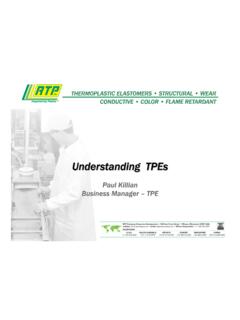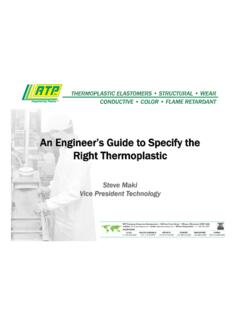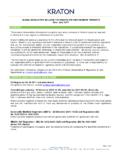Transcription of Flame Retardant Thermoplastics - RTP Company
1 Flame RetardantThermoplasticsCompliant, Cost Effective Solutions Using thermoplastic Technologies2 Your Global Compounder of Custom Engineered Flame Retardant ThermoplasticsThe Bottom Line RTP Company has the breadth and depth of plastics expertise to help you readily meet every demand of the marketplace while supporting you every step of the way. From meeting regulatory approvals, to achieving optimum moldability, to timely delivery and beyond, we make your entire materials sourcing process simpler, more effective, and more You DeliverAs a manufacturer, you face a host of challenges when it comes to specifying the optimum materials for your products.
2 You need to deliver consistent quality, cost-effective solutions, and stay on top of changing global Flame Retardant (FR) regulations. RTP Company can help. Our engineers are experts on constantly-changing FR regulations with the experience, and the approved materials solutions, to help you meet and Unbiased Our portfolio of more than 60 resins and hundreds of modifiers allows us to custom engineer the most effective Flame Retardant solution for your needs, effectively incorporating properties such as strength, wear resistance, flexibility and more. And, while other companies might work in only nylon or only polypropylene, RTP Company s extensive portfolio and expertise ensures you receive the right solution to meet your needs.
3 Our tailored solutions offer superior value to off-the-shelf one size fits all commodity Experience RTP Company produces thousands of different custom engineered Flame Retardant thermoplastic compounds every year. Our customers include global manufacturers and OEMs in industries like electronics, automotive, appliances, electrical products, solar energy, military, aerospace, and Company at a Glance Privately-owned custom compounder Independent, unbiased product development Worldwide representation and distribution Short standard product lead times Global manufacturing sites ISO 9001 Registered facilities3 Flame RetardantsIncrease Product SafetySlowing the Combustion ProcessUsing Flame Retardant technologies to reduce fire hazards is a basic element of product safety.
4 Flame retardancy is achieved in plastics through chemical reactions that moderate one or more of the elements (fuel, heat, or oxygen) necessary for burning to take are a number of ambiguous terms used to describe plastics incorporating Flame Retardant systems, all of which have similar intent: fire Retardant , ignition resistant, and self extinguishing materials. Even with Flame Retardant treatment, no plastic can be rendered entirely fire proof. Flame Retardant systems are meant to moderate, but not eliminate, eventual Retardants Mitigate Fire Danger Increase plastics ignition resistance Reduce the speed of Flame spread Reduce heat release Reduce smoke generationElements of Successful Material Selection Meet appropriate flammability specification Perform in end-use environment with temperature and chemical exposure Resin system with appropriate physical properties at a practical costThe goal of Flame Retardant technology is to disrupt one or more of the fire triangle elements necessary for combustionBurning behavior of plastics is not just a material
5 Characteristic. Part design and nominal wall thickness are key factors in flammability Flame Retardants? Flame Retardant systems are designed to delay ignition and fire spread as a way to increase escape Phase Inhibition MechanismDuring combustion, Flame Retardant additives react with the burning polymer in the vapor phase to disrupt the production of free radicals at a molecular level, thereby shutting down the combustion process. This mechanism is commonly used with halogenated Flame Retardant Phase Char-Formation MechanismChar-forming Flame Retardant additives react to form a carbonaceous layer on the material s surface.
6 This layer insulates the polymer, slowing pyrolysis, and creates a barrier that hinders the release of additional gases that would otherwise fuel combustion. This method is commonly deployed by non-halogen systems using phosphorous and nitrogen and Cool MechanismHydrated minerals make up a class of halogen-free Flame Retardant systems commonly used for extruded applications like wire and cable. These systems use an endothermic reaction in the presence of fire to release water molecules that cool the polymer and dilute the combustion Flame Retardants FunctionWhen exposed to heat or Flame , Thermoplastics undergo pyrolysis, which results in degradation of the resin, releasing gases that become the fuel source for the propagation of Plastics Burn5UL94 The UL94 standard, popularized by Underwriters Laboratories (UL) as an element to obtain a UL Listing for end devices, classifies plastics by how different thicknesses of material burn in various orientations.
7 For example, to achieve the minimum standard UL94 HB, a horizontal specimen less than 3 mm thick must burn at a rate of less than 76 mm/min. The more typical V-0, V-1, and V-2 classification use samples of varying thicknesses, which is an element of the classification. They require a vertical specimen stop burning within a period ranging from 10-30 seconds. The effect of dripped particles is also WireIn Europe, the flammability of plastics is often measured using the glow wire test according to IEC 60695 2 10 following the Glow Wire Flammability Index (GWFI) or Glow Wire Ignition Temperature (GWIT) methods.
8 To pass glow wire tests, a specimen must either have no Flame or glowing for more than 5 seconds while the glow wire is applied for GWIT, or have Flame or glowing that extinguish within 30 seconds after removal of the glow wire for , Smoke and Flame Spread Many other standards can be attributed to factors that are focused on confined space safety and increasing escape time in the event of a fire. The building, transportation, and material handling industries have adopted various test standards that address these concerns, including: Aerospace: FAR Mass Transit: ASTM E162/662 (49 CFR 238) Building: ASTM E84/1354, UL2043 Material Handling.
9 UL2335/FM4996 RTP Company compounds specialized Thermoplastics that can reduce heat, smoke and the spread of flames to meet or exceed the ratings required by these Standards for Flammability( CASE STUDY )SmartPlug Marine Electrical ConnectionObtaining multiple properties in a single material is why custom compounds are often chosen. SmartPlug Systems needed Flame retardancy, impact resistance, and vibrant orange color in a material for their marine shore power and ApprovalsIn-house Lab Expedites DevelopmentRTP Company has in-house laboratory testing expertise, with the ability to perform tests including UL94-HB, V-0, V-1, V-2, 5-V, and VTM; glow wire ignition; FMVSS 302; and FAR test facilities are audited and have been qualified by UL under their Client Test Data Program for more than a decade.
10 RTP Company has a longstanding working relationship with UL, receiving our first recognition in 1977. Our engineers are well versed in managing UL projects and adapting material technologies to evolving UL standards, such as UL1703 for photovoltaic independent labs, RTP Company can obtain data for Limiting Oxygen Index (LOI), smoke density, smoke toxicity, Flame spread, and heat release when needed. UL Yellow CardsRTP Company has over 500 compounds in 30+ polymers with yellow cards that are already UL-Recognized. UL certification of new materials can be expedited with in-house testing as part of UL s Client Test Data Program.









